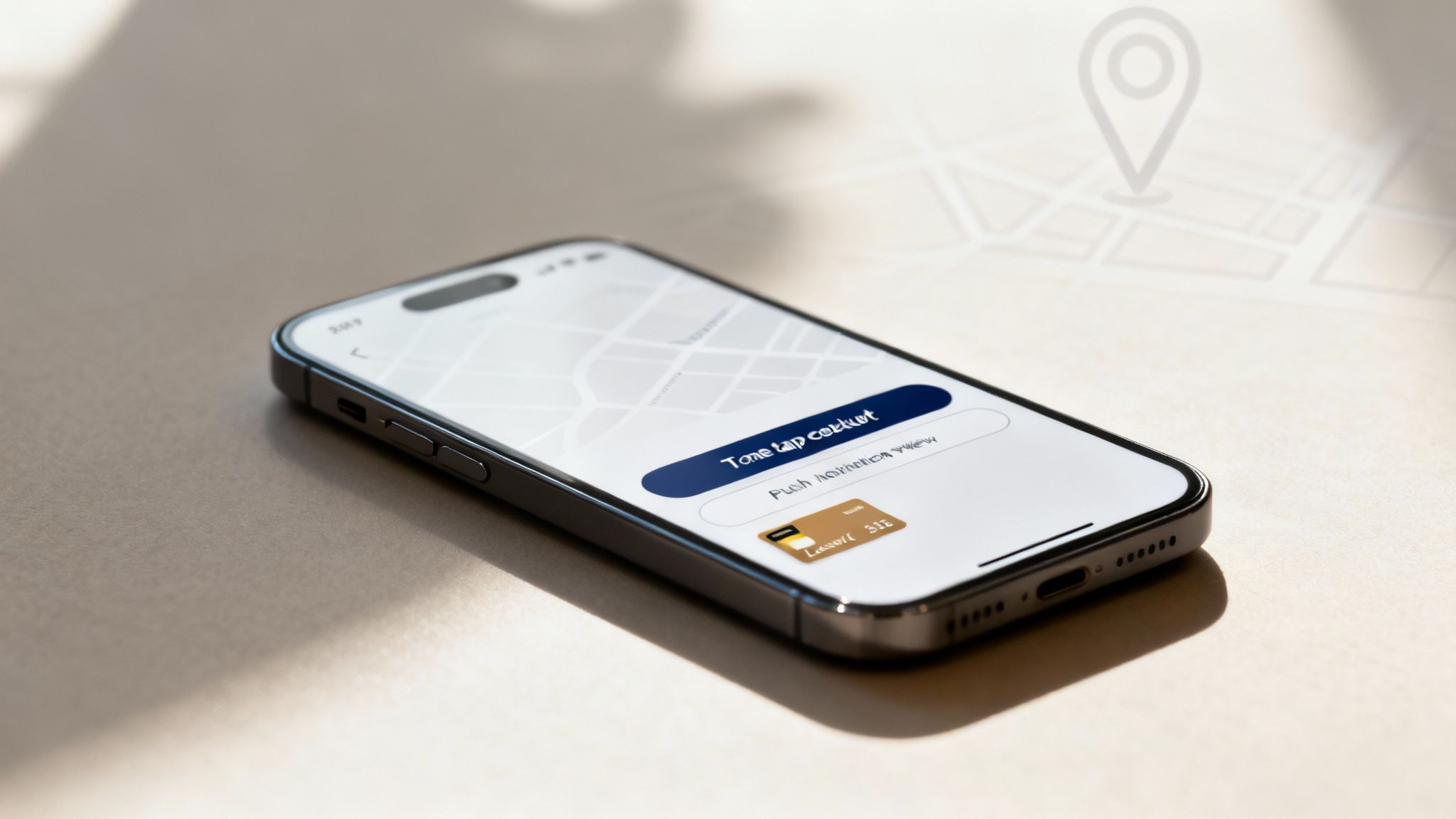In today's fragmented digital landscape, your audience no longer follows a linear path to purchase. A potential client might discover your professional services firm through a LinkedIn article, research your offerings on a third-party review site, engage with a targeted email, and later see a retargeting ad on their favorite news platform. Each of these interactions is a critical touchpoint. Without a cohesive plan, these touchpoints become disjointed, creating a confusing customer experience and leading to inefficient marketing spend. A siloed approach where social media, email, and paid advertising teams operate independently is no longer a viable option for sustainable growth.
The solution lies in building a unified system. Effective multi channel marketing strategies are not just about being present on multiple platforms; they are about orchestrating these channels to work in harmony. This creates a seamless, consistent, and personalized journey for every potential client, from their first point of contact to the final conversion and beyond. By integrating your efforts, you ensure that each channel reinforces the others, amplifying your message and guiding prospects more effectively through their decision-making process. This synergy is what transforms disparate marketing activities into a powerful client acquisition engine.
This article cuts through the noise to provide a comprehensive playbook of 10 proven multi channel marketing strategies tailored for B2B and professional services firms. We move beyond theory to deliver actionable insights. For each strategy, we will detail:
- What it is and why it matters.
- Step-by-step implementation guidance.
- Required technology and data integrations.
- Key KPIs to measure success.
- A concise, real-world example.
This guide is designed to help you build an integrated marketing framework that drives measurable results and fosters lasting client relationships.
1. Omnichannel Customer Experience Integration
Omnichannel integration is an advanced form of a multi channel marketing strategy focused on creating a completely seamless and unified customer journey. Unlike a standard multi-channel approach where platforms may operate independently, an omnichannel strategy ensures that every touchpoint—from your website and social media to email and in-person consultations—is interconnected and consistent. The core principle is that the customer's experience with your brand is continuous, regardless of how or where they choose to interact.

This method creates a cohesive brand narrative, where a client can start a conversation on LinkedIn, continue it via email, and schedule a call through a portal without ever repeating information or feeling a disconnect. For B2B firms, this means a prospect's entire history is accessible to your team, enabling highly personalized and context-aware interactions at every stage.
When to Use This Strategy
This approach is ideal for B2B and professional services firms with complex, high-consideration sales cycles. When a client journey involves multiple decision-makers and touchpoints over several months, an omnichannel experience prevents fragmentation and builds trust. It is particularly effective for firms aiming to establish themselves as market leaders through superior client service and personalization.
Actionable Implementation Steps
- Map the Complete Client Journey: Identify every possible touchpoint a client might have with your brand, from initial awareness to post-project support.
- Invest in a Customer Data Platform (CDP): A CDP or a well-integrated CRM is essential. It must unify data from all sources (website, email, social media, sales calls) into a single client profile.
- Ensure Real-Time Data Sync: Your technology stack, including platforms like Salesforce and Adobe Experience Cloud, must sync data instantly to provide up-to-the-minute client context.
- Train Your Team: Equip your sales, marketing, and client service teams to access and utilize this unified data to deliver personalized service.
- Test and Optimize: Regularly analyze the integrated experience to identify and fix friction points, ensuring a smooth, intuitive journey for every client.
2. Social Media Marketing Integration
Social media integration involves coordinating content and messaging across various platforms like LinkedIn, Twitter, Facebook, and Instagram to build brand awareness and drive engagement. Rather than simply cross-posting the same message, this strategy leverages each platform's unique strengths and audience expectations while maintaining a consistent brand voice. The goal is to create a cohesive presence that meets clients where they are most active.

This approach allows a professional services firm to share thought leadership on LinkedIn, engage in real-time industry conversations on Twitter, and showcase company culture on Instagram, all as part of a unified campaign. By tailoring content to the platform, you can maximize reach and resonance, turning passive followers into active leads. It's a key component in a modern B2B marketer's toolkit of multi channel marketing strategies.
When to Use This Strategy
This strategy is essential for B2B firms looking to build brand authority, generate top-of-funnel leads, and engage with industry communities. It is particularly effective for professional services that want to humanize their brand and connect with decision-makers on a more personal level. If your target audience is active on platforms like LinkedIn or Twitter, an integrated social media approach is non-negotiable for staying relevant.
Actionable Implementation Steps
- Define Platform-Specific Goals: Determine the primary objective for each social channel. For instance, use LinkedIn for lead generation, Twitter for industry news, and Instagram for employer branding.
- Create a Content Calendar: Plan your content 4-6 weeks in advance, creating themes that can be adapted for each platform. This ensures consistency without simple repetition.
- Use Social Listening Tools: Employ tools like Brandwatch or Sprout Social to monitor conversations about your brand, industry, and competitors. Use these insights to inform your content strategy.
- Engage Authentically: Respond to comments and messages promptly. Participate in relevant conversations to establish your firm as an accessible and knowledgeable resource.
- Test and Measure Performance: Use each platform's native analytics to track key metrics like engagement rate, reach, and click-throughs. Continuously refine your approach based on what works. To dive deeper, explore how to build a comprehensive social media strategy for B2B firms.
3. Email Marketing Segmentation and Personalization
Email marketing segmentation is a foundational multi channel marketing strategy that moves beyond generic broadcasts. It involves dividing your audience into smaller, distinct groups based on criteria such as demographics, firmographics, user behavior, and engagement history. Personalization then uses that segmented data to deliver highly relevant content to each group, transforming email into a powerful, one-to-one communication channel.
Instead of sending the same newsletter to every contact, a professional services firm could send case studies relevant to a prospect's industry or an invitation to a webinar about a topic they previously showed interest in. This approach respects the recipient's time and interests, dramatically improving open rates, engagement, and conversion. For B2B marketers, this means nurturing leads with content that directly addresses their specific pain points and stage in the buying journey.
When to Use This Strategy
This strategy is crucial for any B2B or professional services firm looking to build stronger relationships and drive conversions through email. It is particularly effective for businesses with diverse service offerings or those catering to multiple industries. If your lead nurturing feels generic or your email engagement rates are low, implementing segmentation and personalization is a critical step to revitalize your email marketing ROI.
Actionable Implementation Steps
- Define Key Segments: Start by identifying meaningful audience segments. Common B2B segments include industry, company size, job title, website behavior (e.g., downloaded a specific whitepaper), and engagement level.
- Utilize a Capable Email Platform: Invest in an email marketing platform like HubSpot, Mailchimp, or Klaviyo that offers robust segmentation, automation, and dynamic content features.
- Implement Data Collection: Use forms, preference centers, and CRM data to gather the information needed for segmentation. Track on-site behavior to create behavior-based segments.
- Create Personalized Content: Develop content variations tailored to each segment. This can range from different subject lines and calls-to-action to entirely different email bodies using dynamic content blocks.
- Automate Triggered Campaigns: Set up automated email workflows based on user actions, such as welcome series for new subscribers, re-engagement campaigns for inactive contacts, or follow-ups for webinar attendees. Learn more about how to build a winning email campaign on twelverays.agency.
4. Content Marketing Across Multiple Formats
Content marketing across multiple formats is a powerful multi channel marketing strategy that involves creating and distributing valuable content in various forms to engage audiences on their preferred platforms. Instead of relying solely on blog posts, this approach adapts a core message into videos, podcasts, infographics, whitepapers, and interactive tools. The goal is to maximize the reach and impact of your insights by delivering them in the formats your audience loves to consume.
This method ensures your expertise is accessible to different learning styles and consumption habits. For instance, a detailed research report can become a series of digestible blog posts, an engaging webinar, a visually appealing infographic for social media, and an expert interview on a podcast. Companies like HubSpot excel at this, turning a single topic into a comprehensive ecosystem of educational resources that capture leads at every stage of the buyer's journey.
When to Use This Strategy
This strategy is highly effective for B2B firms that need to build authority and educate their market on complex topics. It is ideal when your target audience is diverse, with professionals who may prefer listening to a podcast during their commute, watching a video tutorial, or reading an in-depth whitepaper. Use this approach to establish your brand as a go-to resource and nurture leads over a longer sales cycle.
Actionable Implementation Steps
- Develop a Pillar Content Strategy: Identify a core, high-value topic your firm can own. Create a comprehensive "pillar" piece, like a definitive guide or research report.
- Repurpose Content Intelligently: Break down the pillar content into at least 5-10 smaller "cluster" assets. For example, a whitepaper can be repurposed into blog posts, social media carousels, a webinar, and short-form videos.
- Map Formats to the Customer Journey: Align different content formats with specific stages of the buyer’s journey. Use infographics for awareness, webinars for consideration, and detailed case studies for decision-making. Learn more about how to do this by exploring content marketing best practices.
- Optimize for Each Channel: Tailor the repurposed content for the platform where it will be distributed. A video for LinkedIn should be professional and concise, while a YouTube video can be more detailed.
- Measure Engagement by Format: Use analytics to track which formats resonate most with your audience. Analyze metrics like video view duration, podcast downloads, and infographic shares to inform your future content strategy.
5. Paid Advertising Coordination (PPC, Display, Retargeting)
Paid advertising coordination is a multi channel marketing strategy that synchronizes campaigns across multiple paid platforms like Google Ads, social media, and display networks. Instead of running isolated campaigns, this approach ensures consistent messaging, creative assets, and targeting, creating a unified paid media funnel. This prevents audience fatigue from over-exposure and optimizes budget by allocating funds to the best-performing channels in a cohesive system.
The goal is to guide a prospect through a carefully sequenced advertising experience. For instance, a potential B2B client might first see a brand awareness video ad on LinkedIn, then be retargeted with a case study display ad on industry websites, and finally see a search ad for a specific service when they are ready to make a decision. This method ensures your brand remains top-of-mind with relevant messaging at each stage of the buyer's journey.
When to Use This Strategy
This strategy is essential for any professional services or B2B firm that invests significantly in paid media. It's particularly effective for campaigns with a defined conversion funnel, such as lead generation for a webinar, a demo request, or a free trial signup. If your client acquisition relies on reaching prospects where they are most active online, coordinating your paid efforts is crucial for maximizing ROI.
Actionable Implementation Steps
- Define a Unified Campaign Goal: Establish a single primary objective (e.g., generate 50 qualified leads) that all paid channels will work towards.
- Develop a Multi-Channel Attribution Model: Use tools within Google Analytics or a dedicated platform to understand how each channel contributes to conversions, moving beyond last-click attribution.
- Implement Cross-Platform Conversion Tracking: Ensure pixels and tracking codes from all platforms (Google, LinkedIn, Facebook) are installed correctly on your website and landing pages to measure performance accurately.
- Set Frequency Caps and Audience Exclusions: Prevent ad fatigue by limiting how often a user sees your ads and by excluding audiences who have already converted from seeing lower-funnel ads.
- Synchronize Messaging and Creative: While creative can be adapted for each platform, the core message, offer, and branding should remain consistent to build brand recall and trust. For more specific guidance on refining your search campaigns, explore our Google Ads optimization checklist.
6. Marketing Automation and Lifecycle Management
Marketing automation and lifecycle management is a strategy that leverages technology to streamline, automate, and measure marketing tasks and workflows. It enables businesses to nurture prospects with highly personalized, useful content, helping to convert leads into customers. This approach moves beyond simple email blasts, using behavioral triggers and customer data to deliver the right message at the right moment across various channels.
The core purpose is to manage the entire customer lifecycle, from the initial touchpoint to long-term loyalty, in a scalable and efficient manner. By automating repetitive tasks like email follow-ups, social media posting, and lead scoring, marketing teams can focus on higher-value activities like strategy and creative development. Platforms like HubSpot or Salesforce Marketing Cloud act as the central nervous system for these multi channel marketing strategies, ensuring consistent and contextually relevant communication.
When to Use This Strategy
This strategy is essential for B2B and professional services firms looking to scale their lead generation and nurturing efforts without a linear increase in headcount. It is particularly effective for businesses with longer sales cycles, where maintaining engagement and providing value over time is critical. If your firm needs to manage a growing database of leads and deliver personalized experiences at scale, marketing automation is a key component of your growth engine.
Actionable Implementation Steps
- Map the Customer Lifecycle: Before building any workflow, clearly define the stages of your customer journey, from awareness and consideration to decision and advocacy.
- Select the Right Platform: Choose an automation tool (e.g., Marketo, HubSpot, Pardot) that integrates seamlessly with your existing CRM and other marketing channels.
- Start with Simple Workflows: Begin with foundational automations like a welcome email series for new subscribers or a lead nurturing sequence for downloaded content.
- Implement Lead Scoring: Develop a lead scoring model based on demographic data and user behavior to prioritize the most sales-ready leads for your team.
- Audit and Optimize: Regularly review the performance of your automated campaigns. A/B test emails, adjust timing, and refine messaging based on engagement data and conversion rates. For a deeper dive, explore our guide on marketing automation implementation.
7. Mobile-First and App-Based Marketing
A mobile-first strategy acknowledges that most customers now engage with brands primarily through their smartphones. This approach prioritizes designing and optimizing the entire customer experience for mobile devices first, before adapting it for desktop. It encompasses everything from responsive web design and SMS campaigns to dedicated mobile applications that offer unique value, such as mobile ordering, loyalty programs, or specialized services.

For professional services and B2B companies, this means ensuring your website, client portals, and content are flawlessly accessible on a small screen. It could also involve developing an app that provides clients with direct access to project updates, support, or industry insights. By meeting clients where they are, you reduce friction and create a more immediate, convenient brand connection, much like how Uber's app-first model revolutionized its industry.
When to Use This Strategy
This strategy is essential for any firm whose target audience uses smartphones for business research, communication, or service management. It is particularly effective for businesses that benefit from high-frequency engagement, such as SaaS platforms, or professional services that require ongoing client communication. If your client journey involves on-the-go decision-making, a mobile-first approach is no longer optional.
Actionable Implementation Steps
- Audit Your Mobile Experience: Use Google's Mobile-Friendly Test and real devices to analyze your website's performance, load times, and usability on various screen sizes.
- Prioritize Mobile UX/UI: Design with a "thumb-friendly" mindset. Simplify navigation, use large touch targets, and ensure forms are easy to complete on a small screen.
- Develop a Value-Driven App (If Applicable): If you build an app, ensure it solves a specific client problem or offers exclusive value not available elsewhere, like the Target Circle app does with loyalty rewards.
- Integrate SMS and Push Notifications: Use SMS for time-sensitive alerts and confirmations. Deploy push notifications strategically to provide valuable updates or reminders without being intrusive.
- Optimize for Mobile Speed: Compress images, leverage browser caching, and minimize code to ensure your site loads in under three seconds on a mobile connection.
8. Influencer and Partnership Marketing
Influencer and partnership marketing leverages relationships with key individuals and complementary brands to expand reach and build credibility. This multi channel marketing strategy moves beyond traditional advertising by tapping into the established trust of influencers or partners. This approach can involve micro-influencers with niche audiences, macro-influencers with broad reach, or co-marketing campaigns with non-competing businesses that share a similar target client.
For a B2B SaaS company, this could mean partnering with a well-respected industry consultant to co-host a webinar. A professional services firm might collaborate with a complementary business (e.g., a law firm and an accounting firm) on a joint whitepaper. The goal is to gain authentic, third-party validation and access a pre-qualified audience through a trusted source, cutting through the noise of conventional marketing.
When to Use This Strategy
This strategy is highly effective for B2B firms looking to build brand trust rapidly, enter new markets, or target niche audiences. It is particularly valuable when you need to educate a market about a complex service or technology, as an expert influencer can provide the necessary context and social proof. It's also ideal for enhancing credibility and generating high-quality leads when launching a new service offering.
Actionable Implementation Steps
- Define Clear Goals and Identify Partners: Establish what you want to achieve (e.g., lead generation, brand awareness) and create a profile for your ideal influencer or partner, focusing on audience relevance over sheer follower count.
- Vet Potential Partners Thoroughly: Use tools like HypeAuditor or AspireIQ to analyze an influencer's audience demographics, engagement rates, and authenticity. For brand partnerships, evaluate brand alignment and audience overlap.
- Develop a Mutually Beneficial Proposal: Your outreach should clearly outline the value for both parties. This could be a revenue share, a flat fee, or cross-promotional activities that benefit both brands.
- Grant Creative Freedom with Brand Guardrails: Provide partners with clear brand guidelines but allow them the creative freedom to communicate your message in their own authentic voice. This is crucial for maintaining the trust of their audience.
- Track and Measure Performance: Implement unique tracking links, dedicated landing pages, or promo codes for each partner to accurately measure ROI. Monitor key metrics like referral traffic, lead quality, and conversion rates.
9. SEO and Organic Search Integration
SEO and organic search integration is a foundational multi channel marketing strategy that aligns your content and technical infrastructure with search engine algorithms and user intent. It involves coordinating keyword research, on-page optimization, technical SEO, link building, and content creation across your website, blog, and even social media profiles. The goal is to maximize visibility in search engine results pages (SERPs) and attract highly qualified, high-intent organic traffic.
This approach ensures that your marketing assets are not just created, but are also discoverable. For a professional services firm, this means your white papers, case studies, and service pages appear when potential clients are actively searching for solutions. Companies like HubSpot and Moz have built their businesses by making SEO a central pillar of their content strategy, consistently answering their audience's questions and dominating search results for industry-relevant terms.
When to Use This Strategy
This strategy is non-negotiable for any B2B or professional services firm with a digital presence. It is critical for businesses that rely on inbound lead generation and want to build long-term, sustainable traffic without paying for every click. If your target clients use Google to research problems or find vendors, then integrating SEO into your multi channel marketing strategies is essential for capturing their attention at the most crucial stage of their buying journey.
Actionable Implementation Steps
- Conduct Comprehensive Keyword and Intent Research: Use tools like Ahrefs or SEMrush to identify the primary and long-tail keywords your target audience uses. Crucially, analyze the intent behind these searches (informational, commercial, transactional).
- Optimize On-Page Elements: Ensure every piece of content (blog posts, service pages, case studies) has a unique title tag, meta description, and URL optimized for its target keyword.
- Prioritize Technical SEO: Regularly audit your site for technical health. Focus on improving site speed, ensuring mobile responsiveness, and implementing a clear internal linking structure to help search engines crawl and index your content.
- Build Authority with High-Quality Backlinks: Develop a strategy for earning backlinks from reputable industry websites through guest posting, digital PR, and creating link-worthy content assets.
- Monitor, Analyze, and Refresh: Use Google Analytics and Google Search Console to track your organic traffic, keyword rankings, and click-through rates. Periodically update and refresh existing content to keep it relevant and maintain its ranking.
10. Customer Data Platform (CDP) and Analytics Integration
A Customer Data Platform (CDP) and analytics integration is a foundational multi channel marketing strategy that centralizes client data from every touchpoint. It goes beyond a traditional CRM by consolidating information from your website, email campaigns, social media, and third-party systems into a single, persistent, and unified customer profile. This unified view empowers data-driven decision-making, hyper-personalization, and accurate attribution modeling across all your marketing efforts.
With a CDP like Segment or Salesforce Data Cloud, your firm can move from reacting to client behavior to proactively anticipating their needs. It allows you to see the entire client journey, understand which channels are most effective, and deliver consistent, context-aware messaging. For B2B firms, this means you can identify high-value accounts, score leads with precision, and tailor outreach based on a complete history of interactions.
When to Use This Strategy
This strategy is essential for B2B firms scaling their marketing operations that require a single source of truth for client data. It is particularly crucial when your marketing stack becomes complex and data fragmentation starts to hinder personalization efforts. If your teams are struggling with inconsistent data, poor lead scoring, or an inability to measure multi-channel campaign ROI, implementing a CDP is the next logical step.
Actionable Implementation Steps
- Define Data Governance and Quality Standards: Establish clear rules for data collection, storage, and usage to ensure consistency and compliance with regulations like GDPR and CCPA.
- Start with Core Customer Data: Begin by integrating essential first-party data sources like your CRM, website analytics, and email platform before expanding to more complex data sets.
- Integrate with Your Existing Martech Stack: Ensure the CDP seamlessly connects with your marketing automation tools, analytics platforms, and advertising networks to enable real-time data flow.
- Create Actionable Audience Segments: Use the unified data to build sophisticated client segments based on behavior, firmographics, and engagement history for targeted campaigns.
- Invest in Data Literacy Training: Equip your marketing and sales teams with the skills needed to interpret the data and leverage the CDP's insights to drive strategic decisions.
Multi-Channel Marketing: 10-Point Strategy Comparison
Integrating Your Strategy: From Plan to Profit
We've explored ten powerful multi-channel marketing strategies, from building a truly omnichannel customer experience to harnessing the analytical power of a Customer Data Platform (CDP). Each strategy is a vital piece of the complex machinery of modern B2B and professional services marketing. The journey through these tactics reveals a clear, overarching theme: integration is no longer optional; it is the cornerstone of sustainable growth.
The era of siloed marketing is over. A brilliant email campaign falls short if it isn't supported by coordinated social media messaging. A high-ranking blog post loses impact without a retargeting strategy to re-engage visitors. Your audience doesn't experience your brand in isolated channels; they see one unified entity. Your marketing must reflect that reality.
The Core Takeaway: A Unified Customer View
The central thread connecting all effective multi channel marketing strategies is the pursuit of a single, unified view of the customer. Whether you're segmenting email lists based on website behavior, personalizing content across different formats, or coordinating paid ads with organic search efforts, the goal is the same. You are piecing together data points from various interactions to understand your prospect's needs, challenges, and position in the buying journey.
This unified view allows you to move from broadcasting messages to having meaningful, contextual conversations. It's the difference between a generic newsletter and a targeted email sequence triggered by a specific action. This is where a robust data foundation, powered by a CDP or a well-integrated CRM, becomes your most valuable asset.
Your Actionable Path Forward
Adopting a comprehensive multi-channel approach can feel daunting. The key is to avoid trying to do everything at once. Instead, focus on strategic, incremental implementation that delivers measurable results.
Here are your immediate next steps:
- Conduct a Channel Audit: Begin by evaluating your current marketing channels. Where are you seeing the most engagement? Where are the biggest drop-offs in the customer journey? Identify the two or three most critical channels that your ideal clients use and focus your initial integration efforts there.
- Map the Customer Journey: Don't assume you know how clients find and engage with you. Create a detailed map of the typical journey from awareness to conversion. This will reveal the crucial touchpoints where a seamless, multi-channel experience can have the greatest impact.
- Prioritize Your Tech Stack: Look at the tools you already have. Can your CRM, email platform, and social media scheduler be better integrated? Identify the most significant data gaps and prioritize technology (like marketing automation or a CDP) that can bridge them. The goal is data flow, not just more tools.
- Launch a Pilot Program: Select one specific campaign to serve as your multi-channel pilot. For example, launch a new piece of pillar content and create an integrated plan to promote it across email, social media, and targeted paid ads. Measure everything, learn from the results, and then scale what works.
Mastering these multi channel marketing strategies is about more than just increasing leads; it's about building a resilient, adaptable, and efficient growth engine for your firm. It's about creating a marketing ecosystem where each component amplifies the others, delivering a consistent and compelling brand experience that turns prospects into loyal clients. By focusing on integration, data, and a relentless commitment to understanding your customer, you transform your marketing from a series of disparate tactics into a strategic, profit-generating force.
Ready to stop guessing and start integrating your multi-channel marketing strategies with precision? At Twelverays, we specialize in connecting your marketing channels and CRM data to create a seamless growth engine that delivers measurable ROI. Schedule a consultation with Twelverays to see how we can unify your marketing efforts and drive predictable revenue.





